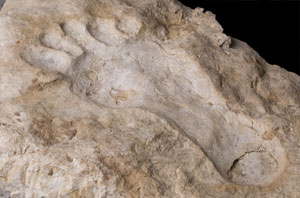
Some of them don’t look like footprints at all. Speaking with Amalyah Hart of Cosmos magazine, Julien Louys, a paleontologist at Griffith University who wasn’t involved in the study, adds, “Some of the footprints look like a bipedal animal, but a lot of the other footprints are very ambiguous and variable in size. “They are interesting and attest to much more favorable climatic conditions, but I don’t think they are directly or indirectly associated with human evolution.”

“All we have from Europe is a group of pre-human apes,” he tells Haaretz. Israel Hershkovitz, a biological anthropologist at Tel Aviv University who was not involved in the research, speculates that the footprints were actually left by a late European ape. Some scientists are skeptical of the study’s claims, doubting that the Graecopithecus freyberg species even existed. “he foot is shaped more like a human hand, with the big toe attached low on the side of the sole and sticking out sideways.” “Non-human ape footprints look very different,” the authors wrote. The pair, who co-authored both the 2017 study and the new paper, added that the impressions “have a shape and form very similar to human tracks,” including five toes without claws, a parallel big toe and a ball of the foot. Writing for the Conversationin 2017, Matthew Robert Bennett, an environmental scientist and geographer at Bournemouth University, and Per Ahlberg, an evolutionary biologist at Uppsala University, said, “The footprints are small tracks made by someone walking upright on two legs.” Proceedings of the Geologists' Association, 2017 Laser scan of one of the best preserved footprints (left) and transverse sections showing concave and convex structures in the impression (right) “The tracks are almost 2.5 million years older than the tracks attributed to Australopithecus afarensis ( Lucy) from Laetoli in Tanzania,” says study co-author Uwe Kirscher, an expert on paleogeography at the University of Tübingen, in a statement.

Researchers say it’s possible the bipedal creature who made the marks was a member of Graecopithecus freyberg, an early human ancestor discovered in 1944 and nicknamed “El Graeco.”

Originally dated to 5.7 million years ago, the 50 footprints might predate this estimate-proposed by scholars in 2017-by more than 300,000 years, according to a paper published in the journal Scientific Reports.īelieved to be left by hominins, the footprints could upend scientists’ understanding of how early humans evolved, moving the group’s starting point from Africa to the Mediterranean Sea, reports Ruth Schuster for Haaretz. New research suggests the controversial fossilized imprints, found on the Greek island of Crete in 2002, are around 6.05 million years old. The oldest known human-like footprints may be even older than previously believed, reports Jacinta Bowler for Science Alert.


 0 kommentar(er)
0 kommentar(er)
